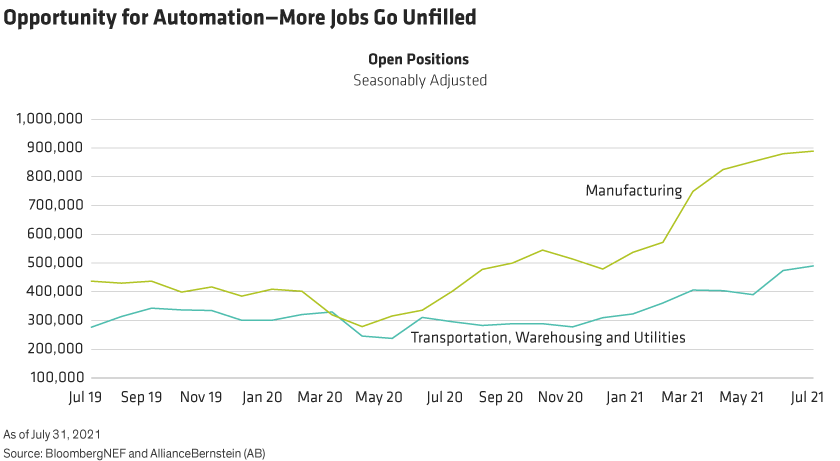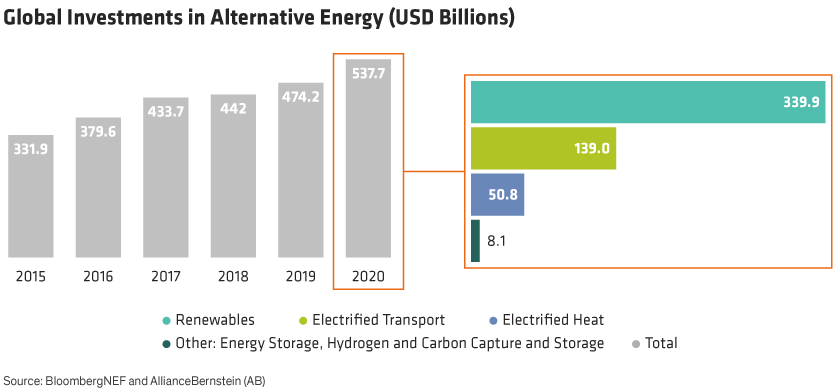by Lei Qiu – Portfolio Manager
Inflation and rising interest rates have prompted many equity investors to reconsider technology and high-growth companies. But this inflationary environment is different, and so are the companies best poised to rise above it.
It’s been a while since rising costs shadowed global equity markets. Some inflation—and rate hikes—are typical in an economic recovery. But after US consumer prices jumped 6.2% in October, the biggest annual inflation surge in three decades, investors sense that it may persist. In fact, the 10-year break-even rate, which gauges investor US inflation expectations for the next decade, reached 2.70% in November—its highest since 2012.
Inflation Pressures May Be Stubborn, but Positive for Disruptors
Historically, inflation and rising rates are no friend to high-growth companies, whose valuations are based on the present value of future earnings. But we believe that the type of inflation unfurling in the post-COVID-19 global economy may add an impetus for high-growth, disruptive companies to outperform.
Some inflationary pressures may be temporary, especially those sparked by shortages due to production shutdowns during COVID-19. And as economies gradually reopen, most prices should normalize as supply and demand dynamics start to rebalance.
Inflation may be more permanent, however, in other corners of the economy where changes are more lasting and impactful. Labor, materials and energy, for instance, were already experiencing steady pre-pandemic shifts that were accelerated by the crisis. And with higher costs likely to persist across the economy, new and industry-changing business models are needed to overcome the added pressures. This is good news for investors who see disruptive innovation as more than a necessity, but an opportunity to invest in tomorrow with significant growth potential today.
Disruptors Target a Changed Workforce and Sticky Wages
Rising labor costs are as much the product of soul searching as job hunting. Wages normally lift when economies rebound, as more people change jobs and companies compete for replacements with higher salaries. But this isn’t a typical hiring boom and the labor market will be forever altered when the dust settles.
Work from home, for example, has changed the way people think about their livelihoods. What started as a smart safety precaution during COVID-19 is now a must-have perk for millions. Many would rather switch jobs than return to offices now. Others are rethinking their work-life balance or early retirement. These and other sobering trends help explain why a record 3% of US workers voluntarily quit in August.
Many job shifters are jumping into the “gig economy,” which ballooned by 2 million people in the US in 2020. Independence, flexibility and some benefits are among the top attractions for gig workers, which number 1.1 billion worldwide. By 2023, projected gross volume of the global gig economy could reach US$455 billion, according to Statista research. These shifting labor dynamics provide fertile sources of labor for companies such as Uber Technologies, Lyft and DoorDash, or more users of online job platforms such as Glassdoor, Indeed and Fiverr. And with new-business startups at an all-time high—4.4 million in the US in 2020, according to the US Census Bureau—demand is surging for innovative recordkeeping and cloud solutions for small businesses, provided by companies such as Bill.com and HubSpot. Worker shortages have especially grown in manufacturing and transportation in recent years.

Yet the trend is also breeding innovation and opportunities for long-term investors. Omnichannel commerce, in which retailers target customers in multiple ways, is taking off, spiking demand for logistics and warehouse workers. For the upcoming holiday season, more retailers are struggling to entice workers despite higher salaries and benefits. So, they’re backfilling thousands of open slots with improved automation and generating lasting demand for robotics and artificial intelligence solutions.
Teradyne’s collaborative robot model, for example, handles mundane tasks such as sorting and bin picking. Enterprise software firm Zebra Technologies optimizes workflows and inventories in warehouses and distribution centers. And someday soon, smart-camera maker Ambarella will help pave the way into a new era of faster long-haul delivery and transportation handled by autonomous driving.
Innovators Reach All Corners of the Economy
Coming off the pandemic, product shortages are rampant. In the auto industry, carmakers’ earnings are being hit by a shortage in microchips, which run everything in modern vehicles. Manufacturing, utilities and mining in general still struggle as well. US industrial production fell 1.3% in September alone—the sharpest drop since February.
Innovative companies are rushing to help, providing smart technology and software to strengthen global supply chains and help production, warehousing, transportation and logistics bounce back. For example, Japan-based Keyence, the leading provider of sensor solutions, is empowering global factory automation while France’s Dassault Systèmes plays an increasingly important role in digitizing and automating 3D and other manufacturing processes.
Energy is being reimagined too. Total capital commitment to new oil projects peaked in 2013 and reached a new trough in 2021, while depletion of the spare capacity is likely behind the global upward pricing pressure in fossil fuel. Meanwhile, the world’s low-carbon push is breeding innovation in energy at a faster clip. In fact, global investment in cleaner fuels and processes grew 9% year over year to US$538 billion in 2020, with renewables and electrified transportation the largest beneficiaries since 2015.

However, the economic path of transition is probably not fast enough to achieve ambitious climate goals. Today, gas and coal still account for over 50% of global power generation. Despite the progress, we believe that more needs to be done to speed up the process toward global net-zero targets, most recently pledged by world leaders at the UN’s COP26 summit, while keeping price appreciation of raw materials in check due to dwindling supplies. In our view, accelerating investment in creative energy initiatives and alternatives is the best path to shrink global reliance on increasingly expensive climate-harmful sources.
This will create investment opportunities in disruptive alternative energy solutions. Growing demand and declining costs should support growth of solar energy enablers, such as inverter manufacturer Enphase Energy and residential solar installer Sunnova Energy International. And electric vehicle adoption cannot be pursued or achieved without the need for materials or battery management solutions provided by companies such as Wolfspeed and Analog Devices, which help improve battery efficiency and range.
Valuation Bias Shouldn’t Obscure Long-Term Opportunities
Inflation and rising rates may affect short-term share prices of fast-growing and innovative companies. We have long believed that disruptive innovation is a deflationary driver across many industries. But in areas where inflationary forces will be more permanent, disruptors will play an even more critical long-term role in navigating the challenges of a post-pandemic economy, providing greater opportunities and surprisingly fast growth.
Lei Qiu is Portfolio Manager—International Technology/Global Disruptors; Senior Research Analyst—Thematic & Sustainable Equities at AllianceBernstein (AB)
The views expressed herein do not constitute research, investment advice or trade recommendations and do not necessarily represent the views of all AB portfolio-management teams and are subject to revision over time.
References to specific securities are presented to illustrate the application of our investment philosophy only and are not to be considered recommendations by AB. The specific securities identified and described do not represent all of the securities purchased, sold or recommended for the portfolio, and it should not be assumed that investments in the securities identified were or will be profitable.













